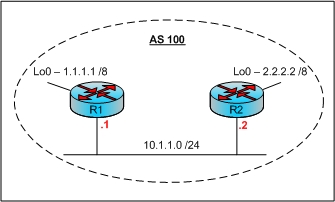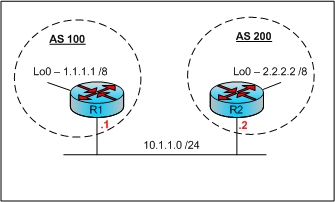Establishing Neighbor Adjacency
Une configuration BGP commence par l’établissement d’une relation de voisinage entre deux routeurs du même AS (iBGP) ou d’AS différents (eBGP)
Ce chapitre traite de :
- iBGP
- eBGP
- Utilisation des « peer-group »
- Utilisation des « template »
- Configuration du « next-hop-self »
- iBGP
Configuration
R1(config)#router bgp 100 R1(config-router)#no synchronization R1(config-router)#no auto-summary R1(config-router)#neighbor 10.1.1.2 remote-as 100 R1(config-router)#network 1.0.0.0 R2(config)#router bgp 100 R2(config-router)#no synchronization R2(config-router)#no auto-summary R2(config-router)#neighbor 10.1.1.1 remote-as 100 R2(config-router)#network 2.0.0.0
Vérifications
R1#show ip bgp BGP table version is 3, local router ID is 1.1.1.1 Status codes: s suppressed, d damped, h history, * valid, > best, i - internal, r RIB-failure, S Stale Origin codes: i - IGP, e - EGP, ? - incomplete Network NextHop Metric LocPrf Weight Path *> 1.0.0.0 0.0.0.0 0 32768 i *>i2.0.0.0 10.1.1.2 0 100 0 i
- * – indique que l’entrée est valide
- > – meilleure entrée pour le préfix
- s – entrée supprimée
- Network – Prefix du réseau annoncé , masque par défaut s’il n’est pas indiqué
- Metric – Métric inter-as –> MED attribut (0 par default)
- LocPrf – Local préférence attribut annoncé par les IBGP
- Weight – poids iBGP ou eBGP (0 à 32768)
- Path – « i » pour IBGP, si non AS number
eBGP

Configuration
R1(config)#router bgp 100 R1(config-router)#no synchronization R1(config-router)#no auto-summary R1(config-router)#neighbor 10.1.1.2 remote-as 200 R1(config-router)#network 1.0.0.0 R2(config)#router bgp 200 R2(config-router)#no synchronization R2(config-router)#no auto-summary R2(config-router)#neighbor 10.1.1.1 remote-as 100 R2(config-router)#network 2.0.0.0
Vérifications
R1#show ip bgp BGP table version is 5, local router ID is 1.1.1.1 Status codes: s suppressed, d damped, h history, * valid, > best, i - internal, r RIB-failure, S Stale Origin codes: i - IGP, e - EGP, ? - incomplete Network Next Hop Metric LocPrf Weight Path *> 1.0.0.0 0.0.0.0 0 32768 i *> 2.0.0.0 10.1.1.2 0 0 200 i
Les « peer-group »
l’utilisation des « peer-group » permet d’optimiser les configurations en appliquant une même configuration à un ensemble de peer , réduisant ainsi considérablement le nombre de ligne de conf dans le cas d’un nombre important de voisin Bgp.
Exemple :
R1(config)#router bgp 100 R1(config-router)#no synchronization R1(config-router)#no auto-summary R1(config-router)#network 1.0.0.0 R1(config-router)#neighbor MY-GROUP peer-group R1(config-router)#neighbor MY-GROUP remote-as 100 R1(config-router)#neighbor MY-GROUP update-source lo0 R1(config-router)#neighbor MY-GROUP version 4 R1(config-router)#neighbor MY-GROUP password cisco R1(config-router)#neighbor 10.1.1.2 peer-group MY-GROUP R1(config-router)#neighbor 10.1.1.3 peer-group MY-GROUP R1(config-router)#neighbor 10.1.1.4 peer-group MY-GROUP R1(config-router)#neighbor 10.1.1.5 peer-group MY-GROUP R1(config-router)#neighbor 10.1.1.6 peer-group MY-GROUP R1(config-router)#neighbor 10.1.1.7 peer-group MY-GROUP
Vérifications
R1#show ip bgp peer-group BGP peer-group is MY-GROUP, remote AS 100 BGP version 4 Default minimum time between advertisement runs is 0 seconds For address family: IPv4 Unicast BGP neighbor is MY-GROUP, peer-group external, members: 10.1.1.2 10.1.1.3 10.1.1.4 10.1.1.5 10.1.1.6 10.1.1.7 Index 0, Offset 0, Mask 0x0 Update messages formatted 0, replicated 0 Number of NLRIs in the update sent: max 0, min 0
« template »
les « template » de configuration BGP permettent également d’optimiser les configurations en ajoutant une notion d’héritage:
R1(config)#router bgp 100 R1(config-router)#no synchronization R1(config-router)#no auto-summary R1(config-router)#network 1.0.0.0 R1(config-router)#template peer-session COMMON R1(config-router-stmp)#password cisco R1(config-router-stmp)#version 4 R1(config-router-stmp)#exit-peer-session R1(config-router)#template peer-session IBGP R1(config-router-stmp)#inherit peer-session COMMON R1(config-router-stmp)#update-source lo0 R1(config-router-stmp)#remote-as 100 R1(config-router-stmp)#exit-peer-session R1(config-router)#neighbor 10.1.1.2 peer-group IBGP R1(config-router)#neighbor 10.1.1.3 peer-group IBGP R1(config-router)#neighbor 10.1.1.4 peer-group IBGP R1(config-router)#neighbor 10.1.1.5 peer-group IBGP R1(config-router)#neighbor 10.1.1.6 peer-group IBGP
« next-hop-self »
« next-hop-self » permet d’indiquer aux peers BGP que l’on est le next-hop (le point de sortie dans la table de routage) des prefix annoncés;
Permet entre autre, de transmettre les prefix appris en EBGP vers les IBGP
router bgp 200 template peer-policy TST next-hop-self exit-peer-policy ! no synchronization bgp router-id 10.2.2.2 bgp log-neighbor-changes network 2.0.0.0 neighbor 10.1.12.1 remote-as 100 neighbor 10.1.234.3 remote-as 200 neighbor 10.1.234.3 next-hop-self neighbor 10.1.234.4 remote-as 200 neighbor 10.1.234.4 inherit peer-policy TST no auto-summary
